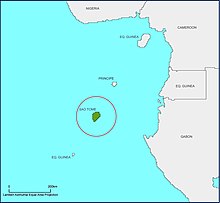São Tomé ibis
Aside from predation, other common threats to the species include overhunting and habitat loss as a result of overexploitation of resources by the people of São Tomé.
[3] Alongside 19 other endemic species of birds, the São Tomé ibis is one of the 10 that are threatened for extinction, but little has been done to protect the island's very high biodiversity.
The nests appear both higher up and away from running water, most likely to avoid snakes and introduced mammals that could exploit the eggs, such as rats and Mona monkeys.
[3] It forages for food on the forest floor with sparse undergrowth, especially where the ground has been disturbed by feral pigs, and in swampy areas bordering watercourses.
[6] Living in the Anthropocene, the São Tomé ibis suffers from anthropogenic factors, including habitat destruction, overhunting, and urbanization.
[7] Oil-palm concessions are the licensing of specific land by governmental organizations to companies to build oil palm plantations.
When more people visit the island, more resources are required to sustain them, explaining the additional increase in logging and contributing to the limiting of the ibis's available habitat and breeding range.
Whether it is hunting for sport or accidental killings, the ibis population is decreasing in ways that are not attributable to simply the overexploitation of resources and the environment.
Biodiversity research in all of the Gulf of Guinea has been limited in the past due to political instability, economic collapse, and agricultural focuses.
The ECOFAC program was designed to fund various studies in São Tomé and Príncipe centered around biodiversity and conservation.
Specifically, it led to the creation of the Bom Sucesso Botanical Garden, which is the gateway to the Obô National Park in São Tomé.
International organizations have also begun to get involved in conservation in São Tomé, which has trickle-down effects to helping the dwarf ibis.
Specifically, the study highlighted how important it was to raise awareness both in and out of the country so that people would mobilize to help save the species.
In order to combat the problems of over hunting, habitat loss, and tourism, it is advisable to work directly with the hunters and tourist companies to attempt to resolve the issue.
While working with the problem seems like a smart choice to make, a fundamental attitude change needs to happen to shift the locals' focus away from extraction and towards conservation.



